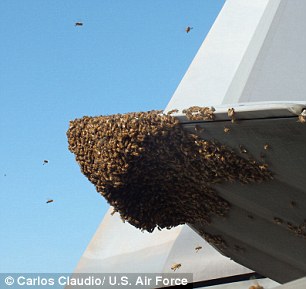US Air Force's F-22 Raptor grounded by BEES: Maintenance crew discovers nearly 20,000 honey bees swarming the fighter jet's exhaust nozzle
- The colony weighed eight pounds, translating to almost 20,000 bees
- Experts say they were likely relocating from larger hive on the base
- The colony was safely transferred, to be housed by a local beer producer
It’s been called the best stealth fighter in the world, but the US Air Force’s F-22 Raptor proved no match for a colony of honey bees in search of a new home for their queen.
After flight operations in Virginia, the maintenance crew discovered ‘what looked like a cloud of thousands of bees' hanging from the jet’s exhaust nozzle.
Despite their initial shock, the team did not call an exterminator – instead the colony was safely relocated to provide honey for a local beer producer.

After flight operations in Virginia, the maintenance crew discovered ‘what looked like a cloud of thousands of bees hanging from the jet’s exhaust nozzle. Despite their initial shock, the team did not call an exterminator
The swarm of honey bees was discovered on June 11 following operations at Joint Base Langley-Eustis, Virginia hanging from the exhaust of the $150 million fighter jet.
‘I was shocked like everyone else because it looked like a cloud of thousands of bees, but I knew they wouldn’t sting anyone and were just looking for a new place to live,’ said Tech. Sgt. Jeffrey Baskin, 192nd Maintenance Squadron crew chief.
Understanding the critical role of these pollinators in the ecosystem, Baskin ‘figured we might want to get a honey bee expert out to collect them.’
The crew consulted with an on-base entomologist, who called upon US Navy retired local bee keeper, Andy Westrich.

According to Capt. Katie Chiarantona, 192nd Aircraft Maintenance Officer, the bees may have used the fighter jet as a resting place before continuing their journey in the morning, or they may even have decided to build their hive on the jet engine
According to Westrich, the swarm was one of the largest he’d ever seen, and collectively, the colony weighed eight pounds – translating to almost 20,000 bees.
While it may seem unusual, the experts explain that this phenomenon likely falls in line with standard honey bee behaviour.
‘The honey bees most likely came from a much larger bee hive somewhere else on base,’ said Chief Master Sergeant Gregg Allen, 192nd Maintenance Group Quality Assurance chief – who is also a beekeeper.


The crew consulted with an on-base entomologist, who called upon US Navy retired local bee keeper, Andy Westrich, who said the swarm was one of the largest he’d ever seen. Collectively, the bees weighed eight pounds – translating to almost 20,000 bees

The swarm of honey bees was discovered on June 11 following operations at Joint Base Langley-Eustis, Virginia hanging from the exhaust of the $150 million fighter jet
‘Bee hives are constantly growing and they eventually become overcrowded. Around springtime, the bees will make a new queen, scout for a new location and take half of the hive with them to that location.
According to Capt. Katie Chiarantona, 192nd Aircraft Maintenance Officer, Westrich says the bees may have used the fighter jet as a resting place before continuing their journey in the morning, or they may even have decided to build their hive on the jet engine.
The colony was relocated safely to be maintained by a local beer producer, who will use the honey for their production facility.
‘Every bee is important to our food source; lots of things would die without bees,’ said Baskin.
‘Most of our crops depend on bees, and our bees need to pollinate. This is why I knew we needed to save them instead of [exterminate] them.’
| Role | Air Superiority / Multi-purpose fighter |
| Engines | 2 P&W F119-PW-100 turbo fans |
| Thrust | 35,000 pounds x2 |
| Wingspan | 44 feet 6 inches |
| Length | 62 feet 1 inch |
| Height | 16 feet 8 inches |
| Speed | Mach 2 |
| Range | 1,850 miles |
| Ceiling | Above 50,000 feet |
| Crew | 1 |
| Cost | $150million |
| Armaments | One M61A2 20-millimeter cannon with 480 rounds |
| Side Weapons Bay | Two AIM-9 heat seeking missiles |
| Air-to-air load (Internal Weapons Bay) | Six AIM-120 radar-guided air-to-air missiles |
| Air-to-ground load (Internal Weapons Bay) | Two 1,000-pound GBU-32 JDAMs and two AIM-120 radar-guided air-to-air missiles |
Most watched News videos
-
 Terminally ill woman holds two-day party for her 30 closest...
Terminally ill woman holds two-day party for her 30 closest...
-
 He is human after all! Michael Phelps LOSES his final...
He is human after all! Michael Phelps LOSES his final...
-
 Sore losers! USA goalie Hope Solo rants 'we lost to a bunch...
Sore losers! USA goalie Hope Solo rants 'we lost to a bunch...
-
 Historic moment for the Olympics as female sprinters from...
Historic moment for the Olympics as female sprinters from...
-
 Revealed: Brother of 10-year-old Kansas boy who was...
Revealed: Brother of 10-year-old Kansas boy who was...
-
 'If you get raped by a pack of n*****s it’ll be your fault':...
'If you get raped by a pack of n*****s it’ll be your fault':...
-
 'I gave up': New York boy, 13, who took his own life after...
'I gave up': New York boy, 13, who took his own life after...
-
 SEBASTIAN SHAKESPEARE: Oh-la-la! William and Kate's holiday...
SEBASTIAN SHAKESPEARE: Oh-la-la! William and Kate's holiday...
-
 Making a Murderer's Brendan Dassey has his conviction...
Making a Murderer's Brendan Dassey has his conviction...
-
 Defeated Egyptian judoka REFUSES to shake hands with Israeli...
Defeated Egyptian judoka REFUSES to shake hands with Israeli...
-
 House 'filled with cat urine and rotten food' is discovered...
House 'filled with cat urine and rotten food' is discovered...
-
 'It felt like we dropped 50 stories in an out of control...
'It felt like we dropped 50 stories in an out of control...














































































































































































































































 Parents share the candid and very messy reality behind those 'perfect' Instagram shots - and it will make you feel a LOT better
Parents share the candid and very messy reality behind those 'perfect' Instagram shots - and it will make you feel a LOT better